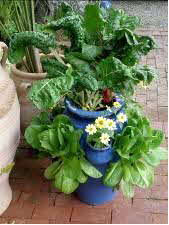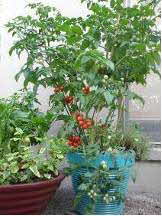SIX STEPS FOR CONTAINER GARDEN SUCCESS
|
|
You don't need a plot of land to grow fresh vegetables and herbs. Herbs are a common choice for container gardeners, but many vegetables lend themselves well to container gardening too. With some thought to selecting bush or dwarf varieties, almost any vegetable can be adapted to growing in a pot. Vegetables that take up little space, such as carrots, radishes and lettuce, or crops that bear fruits over a long period of time, like tomatoes and peppers, are perfect for container gardens.
What you can grow in containers is limited only by the size of the container and your imagination. How about a Summer Salad container? Plant a tomato, a cucumber and some parsley or chives all in a large (24-30") container. They grow well together and have the same water and sun requirements.
Here’s six steps for container garden success

1. Time-saving transplants - When you're ready to begin potting up vegetables and herbs, opt for transplants - seedlings that have already been started - rather than starting from seed. Transplants will buy you lots of time because plants are six weeks or older when you put them in the pot, and you'll begin harvesting much sooner. Bonnie Plants offers a wide variety of veggie and herb transplants, (many are compact varieties perfect for containers) available at garden retailers nationwide and grown near you.
2. Use a premium quality potting mix. Don't skimp here. A quality mix holds moisture and drains well, giving plant roots the perfect balance of air, moisture, and stability to grow a great harvest. Read bag labels to look for quality ingredients: sphagnum peat moss, aged (composted) bark, perlite, lime or dolomite, and sometimes moisture-holding crystals. Quality potting mix stays fluffy all season long. It does not contain actual dirt that would compact with frequent watering.
3. Pick the right pot. It should be affordable to buy and fill, and large enough to accommodate your plants as they mature. Almost anything can serve as a container– flower pots, pails, buckets, wire baskets, bushel baskets, washtubs, window planters, even large food cans. Larger veggies, like tomatoes and eggplants, will need a larger container, at least 5 gallons for each plant. When in doubt, bigger is always better, the plants will look better and last longer because the roots will have more room to grow. Be sure that the pot has a drainage hole in the bottom.

4. Feed your plants. Even if your potting mix came with fertilizer already mixed in, you may need to feed your plants. Some potting mixes include just enough fertilizer to give plants a charge when they’re starting. Mixes designed to feed for several months run out sooner in hot weather with frequent watering. Add timed-release granules or try a soluble fertilizer such as the “little green jug” of Bonnie Plant Food for quick results. It’s organic in nature, environmentally friendly, an excellent food source for beneficial organisms in the soil and helps support healthy soil and overall plant growth.
5. Put pots in a sunny spot. At least 6 hours is best. The sun drives energy for production and for making sugars, acids, and other compounds responsible for the fullest flavor. Make sure pots on a deck or porch get enough sunlight and move them to a sunny spot if shade encroaches.
6. Water regularly. Vegetables are at least 90% water. To produce well, they may need daily watering in hot weather. The easiest way to do this is set up a drip system on a timer. It's a little more work on the front end, but it makes for as close to auto-pilot watering as you can get. (Most herbs, except the big-leaved ones like basil, can get by with a little less water.) Be sure to water before the sun goes down, leaves will need to dry before nightfall.
Be on the lookout for key words like: bush, compact, and space saver. Here are some veggie and herb varieties to get your container gardens growing.
- Eggplant: Hansel Mini eggplant
- Green Beans: (Pole beans give a higher yield in a small footprint) Blue Lake, French Dwarf
- Leaf Lettuce: Buttercrunch, Bibb
- Peppers: Cubanelle, Sweet Banana, Jalapeno
- Tomatoes: Patio, Husky cherry Red, Sweet and Neat, Bush Early Girl, Bush Goliath, and Better Bush
- Greek Columnar Basil
- Any herb will do well in a pot!
For more information on vegetable and herb varieties, gardening tips, ideas and advice, visit www.bonnieplants.com
RELATED ARTICLES:
Please feel free to link to any pages of FoodReference.com from your website.
For permission to use any of this content please E-mail: james@foodreference.com
All contents are copyright © 1990 - 2014 James T. Ehler and www.FoodReference.com unless otherwise noted.
All rights reserved.
You may copy and use portions of this website for non-commercial, personal use only.
Any other use of these materials without prior written authorization is not very nice and violates the copyright.
Please take the time to request permission.
CULINARY SCHOOLS &
COOKING CLASSES
From Amateur & Basic Cooking Classes to Professional Chef Training & Degrees
More than 1,000 schools & classes listed for all 50 States, Online and Worldwide
FREE Food & Beverage Publications
An extensive selection of free magazines and other publications for qualified Food, Beverage & Hospitality professionals


